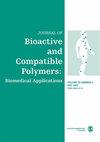Calcium phosphate graphene with tailorable phosphate and oxygen content for increased osteogenic activity
IF 2.2
4区 生物学
Q3 BIOTECHNOLOGY & APPLIED MICROBIOLOGY
引用次数: 0
Abstract
The treatment of critical bone injuries using autografts and metallic hardware, though effective, carries drawbacks yet to be addressed by modern interventions. One way that researchers have sought to avoid these complications is using bioresorbable synthetic grafts. Ideally, these materials possess mechanical properties like that of bone and support the site of injury until absorbed and replaced by native bone. In this work we seek to continue the work of optimizing the synthesis of one synthetic graft candidate, calcium phosphate graphene (CaPG). CaPG is a functional graphenic material (FGM) made using the Arbuzov reaction to covalently seed polyphosphates on the graphenic backbone. This material releases calcium and phosphate ions and has been shown to induce osteogenesis. Herein, we investigate reaction conditions and demonstrate the ability to tailor the functionalization of CaPG. The differences in these properties were found to affect mechanical properties, ion elution, as well as calcium deposition of stem cells when measured via Alizarin Red S (ARS). These results continue to demonstrate the potential of CaPG scaffolds as tunable materials to promote bone regeneration.磷酸钙石墨烯具有可定制的磷酸和氧含量,可提高成骨活性
使用自体移植物和金属硬件治疗严重骨损伤虽然有效,但也存在着现代干预措施尚未解决的缺点。研究人员试图避免这些并发症的一种方法是使用生物可吸收合成移植物。理想情况下,这些材料具有与骨骼相同的机械特性,能支撑受伤部位,直至被本地骨骼吸收和替代。在这项工作中,我们试图继续优化合成移植物候选材料--磷酸钙石墨烯(CaPG)的合成。CaPG 是一种功能性石墨烯材料 (FGM),利用阿尔布佐夫反应在石墨烯骨架上以共价方式种下多磷酸盐。这种材料能释放钙离子和磷酸根离子,已被证明能诱导成骨。在此,我们研究了反应条件,并展示了定制 CaPG 功能化的能力。通过茜素红 S(ARS)测量,发现这些特性的差异会影响机械特性、离子洗脱以及干细胞的钙沉积。这些结果继续证明了 CaPG 支架作为可调材料促进骨再生的潜力。
本文章由计算机程序翻译,如有差异,请以英文原文为准。
求助全文
约1分钟内获得全文
求助全文
来源期刊

Journal of Bioactive and Compatible Polymers
工程技术-材料科学:生物材料
CiteScore
3.50
自引率
0.00%
发文量
27
审稿时长
2 months
期刊介绍:
The use and importance of biomedical polymers, especially in pharmacology, is growing rapidly. The Journal of Bioactive and Compatible Polymers is a fully peer-reviewed scholarly journal that provides biomedical polymer scientists and researchers with new information on important advances in this field. Examples of specific areas of interest to the journal include: polymeric drugs and drug design; polymeric functionalization and structures related to biological activity or compatibility; natural polymer modification to achieve specific biological activity or compatibility; enzyme modelling by polymers; membranes for biological use; liposome stabilization and cell modeling. This journal is a member of the Committee on Publication Ethics (COPE).
 求助内容:
求助内容: 应助结果提醒方式:
应助结果提醒方式:


